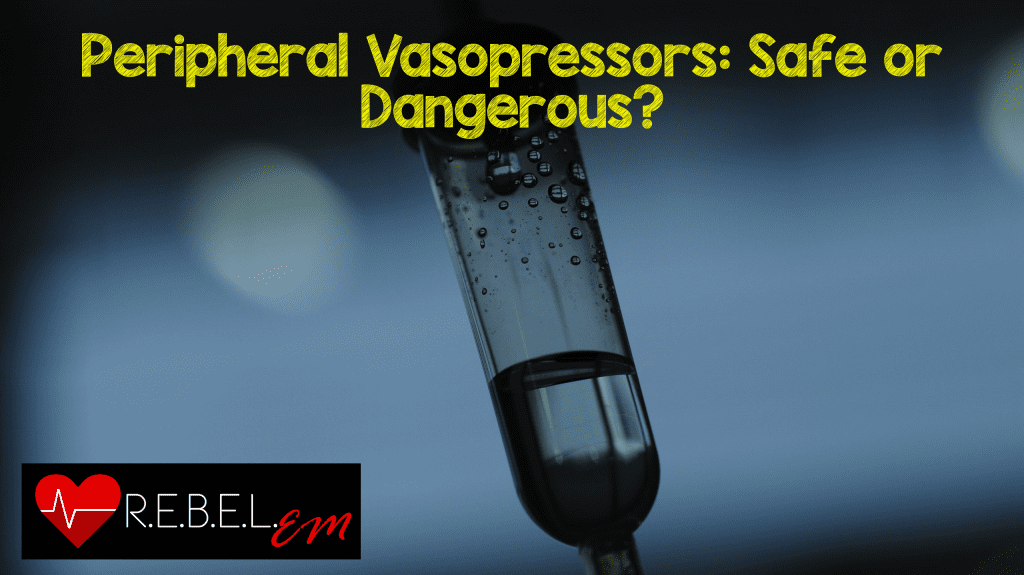
 Background: We have discussed the safety of peripheral vasopressors on REBEL EM before. In that review by Loubani et al was a systematic review of 85 articles and 270 patients. 95% of the extravasation events occurred in PIVs with infusions running greater than 4 hours and 85% of extravasation events occurred in PIVs distal to the antecubital fossa. The major limitation of this systematic review is that the majority of the data was derived from case reports and case series and not prospective trials. The authors of this current study sought to determine the incidence of complications of running vasopressors through PIVs in patients with circulatory shock in a prospective, observational trial.
Background: We have discussed the safety of peripheral vasopressors on REBEL EM before. In that review by Loubani et al was a systematic review of 85 articles and 270 patients. 95% of the extravasation events occurred in PIVs with infusions running greater than 4 hours and 85% of extravasation events occurred in PIVs distal to the antecubital fossa. The major limitation of this systematic review is that the majority of the data was derived from case reports and case series and not prospective trials. The authors of this current study sought to determine the incidence of complications of running vasopressors through PIVs in patients with circulatory shock in a prospective, observational trial.
What They Did:
- Prospective observational study of patients with circulatory shock receiving vasopressors through a peripheral IV
- Determine the complication rate from administration of vasopressors through peripheral IVs
Outcomes:
- Primary: Complication rate
- Minor Complications: drug extravasation, thrombophlebitis, and localized cellulitis
- Major Complications: tissue necrosis and limb ischemia
Inclusion:
- Patients presenting to the ED with circulatory shock
- Vasopressor initiation through a PIV
Exclusion:
- Refusal of consent (13 patients could not be recruited)
Results:
- 55 patients included
- In-Hospital Mortality Rate: 32.1%

- Types of Shock:
- Septic: 83.6%
- Cardiogenic: 10.9%
- Hypovolemic/Hemorrhagic: 5.5%
- Vasopressors Used:
- Norepinephrine: 90.9%
- Dopamine 9.1%
- Site of PIV
- External Jugular: 3.6%
- Upper Arm: 1.8%
- Antecubital Fossa: 40%
- Forearm: 18.2%
- Hand 36.4%
- Catheter Gauge
- 16: 10.9%
- 18: 36.4%
- 20: 50.9%
- 22: 1.8%
- Median Duration of Vasopressor Infusion (Hrs):
- Norepinephrine or Dopamine: 14 (Range 7 – 40)
- Norepinephrine: 13 (Range 6.5 – 31.5)
- Dopamine: 53 (15.5 – 113)
Strengths:
- Research fellows role was entirely observational and did not influence decisions
- IVs physically examined 2x/day during vasopressor infusion and then daily up to 48 hours after discontinuation of vasopressor
- Prospective study
Limitations:
- Small patient population
- Single center trial
- Only norepinephrine and dopamine were studied (i.e. would have been nice to have a real mix of pressors such as epinephrine, etc)
- No randomization
- No comparator group
Discussion:
- All 3 complications occurred in patients with 20g catheters, but due to the small number of complications it is difficult to conclude that 20g catheters should not be used
- Specifics of the 3 complications:
- Patient 1: Local thrombophlebitis. Norepinephrine (8mg in 250mL D5W) through 20g catheter in right hand. Vasopressor infused for 40hrs with maximal infusion rate of 7ug/min
- Patient 2: Skin Pallor. Norepinephrine (8mg in 250mL D5W) through 20g catheter in left hand. Vasopressor infused for 11hrs with maximal infusion rate 7ug/min
- Patient 3: Non-Blanching Skin Erythema. Norepinephrine (8mg in 250 ML D5W) through 20g catheter in antecubital fossa. Vasopressor infused for 28hrs with maximal infusion rate19ug/min
Author Conclusion: “The incidence of complications from the administration of vasopressors through a PVC is small and did not result in significant morbidity in this study. Larger prospective studies are needed to better determine the factors that are associated with these complications, and identify patients in whom this practice is safe.”
Clinical Take Home Point: In patients with shock, use of peripheral vasopressors (Norepinephrine and Dopamine) in a large bore IV (18 – 20g) at a proximal site (antecubital fossa or more proximal) run for ≤4hrs or less is a safe option until more central access can be achieved.
References:
- Medlej K et al. Complications from Administration of Vasopressors Through Peripheral Venous Catheters: An Observational Study. JEM 2018. PMID: 29110979
For More Thoughts on This Topic Checkout:
- REBEL EM: Mythbuster – Administration of Vasopressors Through Peripheral Intravenous Acces
- PulmCrit: Do Phenylephrine and Epinephrine Require Central Access
- EMCrit: Peripheral Vasopressor Infusions and Extravasation
- PulmCast: Peripheral Vasopressors – Are my days of Placing Central Lines Over? Not Yet?
Post Peer Reviewed By: Anand Swaminathan swisstimepieces (Twitter: @EMSwami)
The post Peripheral Vasopressors: Safe or Dangerous? appeared first on REBEL EM - Emergency Medicine Blog.
